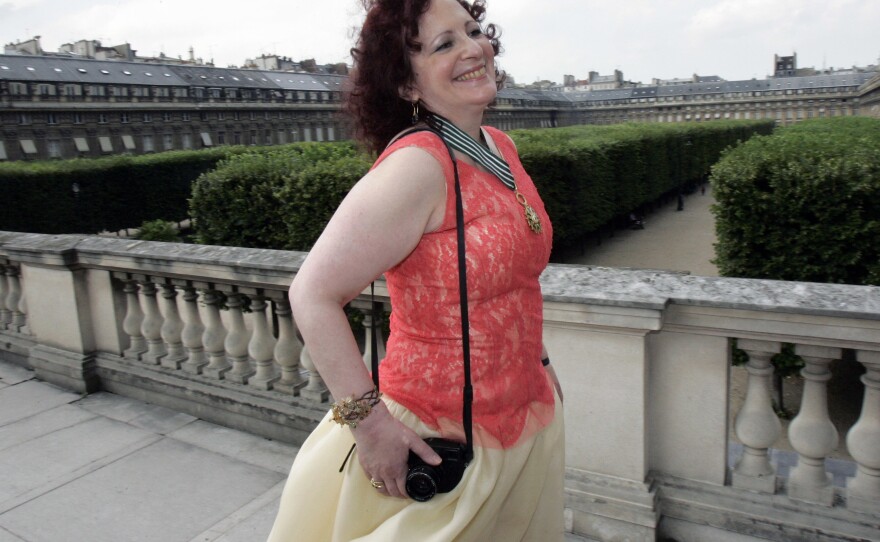The first couple times I talked with photographer Nan Goldin, I saw her rage and frustration over the prescription opioid epidemic that derailed her life and killed tens of thousands of Americans.
"I've never seen such an abuse of justice," Goldin told me.
She was talking about members of the Sackler family, who own Purdue Pharma, the maker of Oxycontin.
Goldin herself became addicted to pain pills after surgery. She later came to believe the Sacklers lied about their drug's safety and were unlikely to be held accountable.
"It's shocking. It's really shocking. I've been deeply depressed and horrified," she said.
What I missed in those encounters with Goldin — hidden behind the chain smoking and the weary laugh — was the power, stubbornness and battle-hardened courage that helped her take on the Sacklers.
That's the revelation in the new documentary about Goldin, All The Beauty and The Bloodshed, out now in limited release. It won the Gold Lion for best film this year at the Venice International Film Festival.
The film by Laura Poitras shows Goldin growing up in an abusive family, surviving foster care and living homeless in New York City.
Goldin clawed her way into the art world as one of the rawest most powerful photographers of her generation. To pay the bills — and cover the cost of film — Goldin often danced in strip clubs and did sex work.
"Photography was always a way to walk through fear," Goldin says in the documentary. "It gave me a reason to be there."
She was later one of the earliest American artists to take on the AIDS epidemic, mounting a show in the late 1980s that drew national attention and controversy.
The Sackler family, meanwhile, was growing fabulously wealthy, first by selling Valium and then aggressively marketing Oxycontin.
Many of the same museums around the world that were beginning to collect Goldin's photographs were also naming buildings after the Sacklers — in exchange for lavish donations.
The collision between the Sacklers and Goldin portrayed in this film came after Goldin's recovery from years of opioid addiction, a time she describes as "a darkness of the soul."
After reading about the Sacklers' role pushing Oxycontin sales in a groundbreaking article in The New Yorker, Goldin decided to challenge their carefully curated public image as enlightened philanthropists.
"All the museums and institutions need to stop taking money from these corrupt evil bastards," Goldin says in the documentary, as she helps organize one of the opioid protests that rocked the art world over the last five years.
It wasn't clear Goldin's campaign would work. The Sacklers ranked among the most widely respected and deeply connected art patrons.
"The museums...tried to pretend it wasn't happening," said director Laura Poitras in an interview with NPR. "None of them responded."
But Goldin kept pushing, mounting more protests and publishing a scathing personal essay in the influential journal Artforum.
"She knew how to use her power. She's a figure these museums wanted to work with," says David Velasco, Artforum's editor in chief, in the documentary.
It's important to say the Sacklers have long denied any wrongdoing.
Their company has twice pleaded guilty to federal criminal charges relating to opioid marketing and Purdue Pharma is now in bankruptcy.
But members of the Sackler family who directed the company and profited from opioid sales have never been charged with any crime.
While they've given up control of their company and are expected to pay billions of dollars as part of a settlement deal, they are likely to retain much of their wealth.
They have, however, faced a different kind of accountability.
In bestselling books such as Empire of Pain: The Secret History of the Sackler Dynasty, the book and award-winning television series Dopesick, and this new documentary, the Sacklers have faced a kind of public shaming.
The Sackler name has been stripped from buildings and exhibition spaces in the Guggenheim, the Louvre, the Met, and other top cultural and educational institutions around the world.
In my conversations with Goldin, she's described this as a thin sort of victory, weighed against the carnage of an opioid crisis that's still raging.
Hundreds of thousands of Americans have already died. Fatal overdoses, driven now mostly by the illicit street opioid fentanyl, hit a devastating new record in 2021.
In the documentary, however, Goldin allows herself a moment of triumph. She walks through an exhibition space in the Met, where the Sackler name has been scoured from the wall.
"Congress didn't do anything, the Justice Department didn't do anything," Goldin says. "This is the only place they're being held accountable, the only place. We did it."
Copyright 2022 NPR. To see more, visit https://www.npr.org. 9(MDAzMjM2NDYzMDEyMzc1Njk5NjAxNzY3OQ001))







